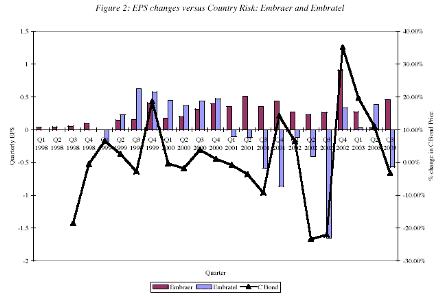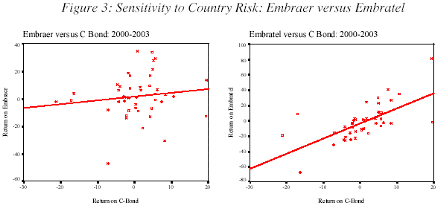As investors, we are more interested in a company’s earnings than its revenues. Consequently, an argument can be made that we should be looking at how exposed a company’s earnings are to country risk. In theory, at least, the earnings of a company that is more exposed to country risk should increase as country risk decreases and decrease as country risk exposes. There are three practical problems, though, with using accounting earnings in measuring country risk:
1. Earnings often lag changes in the underlying fundamentals at a company. In other words, the earnings changes are likely to occur well after the change in country risk occurs.
2. Earnings can be smoothed out even for companies that are exposed to country risk. On the surface, these companies look far safer and less exposed to country risk than they truly are.
3. Accounting earnings are measured four times a year, at the most, and less often in some emerging markets. With the resulting small sample, it may be difficult to draw any conclusions.
Consider again Embraer and Embratel. In figure 2, we graph the percentage changes in quarterly earnings per share for each firm in Brazilian Real from 1999 to 2002 and compare them to percentage changes in the C-Bond price each quarter:

Note that Embratel earnings are much more sensitive to country risk than Embraer earnings. In 2002, in particular, Embratel earnings declined as country risk increased bu Embraer earnings were unaffected.
Market Prices
Unlike accounting earnings and revenues, which are measured only a few times each year and lag changes in the firm, stock prices are updated through every trading day and reflect investor assessments, faulty though they may be sometimes, of the effects of new information (including changes in country risk). If we can come up with market measures of country risk, we can measure the sensitivity of a company’s stock price to country risk to estimate its lambda.
Bonds issued by countries offer a simple and updated measure of country risk. As investor assessments of country risk become more optimistic, bonds issued by that country go up in price, just as they go down when investors become more pessimistic. A regression of the returns on a stock against the returns on a country bond should therefore yield a measure of lambda in the slope coefficient. Note that this parallels the approach that we often use to get a company’s beta.
The difference lies in the independent variable used, since the returns on an equity index are used to estimate betas. Applying this approach to Brazil is relatively straightforward. The Brazilian CBond, which we used earlier to get the default spread, is widely traded and returns on the bond are available going back to 1998. We regressed monthly stock returns on Embraer and Embratel against monthly returns on the C-Bond and the resulting graphs are shown in figure 3:

The regression results are summarized below for the two companies:
ReturnEmbraer = 0.0195 + 0.2681 ReturnC Bond
ReturnEmbratel = -0.0308 + 2.0030 ReturnC Bond
Based upon these regressions, Embraer has a lambda of 0.27 and Embratel has a lambda of 2.00. The resulting dollar costs of equity for the two firms, using a mature market equity risk premium of 4.53% and a country equity risk premium of 7.67% for Brazil are:
Cost of Equity for Embraer = 4.05% + 1.07 (4.53%) + 0.27 (7.67%) = 10.97%
Cost of Equity for Embratel = 4.05% + 0.80 (4.53%) + 2.00 (7.67%) = 23.01%
What are the limitations of this approach? The lambdas estimated from these regressions are likely to have large standard errors; the standard error in the lambda estimate of Embratel is 0.35. It also requires that the country have bonds that are liquid and widely traded, preferably in a more stable currency (dollar or euro). While there are more country bonds in circulation now, there are dozens of countries where the data is not available.
Risk Exposure in Many Countries
The discussion of lambdas in the last section should highlight a fact that is often lost in valuation. The exposure to country risk, whether it is measured in revenues, earnings or stock prices, does not come from where a company is incorporated but from its operations. There are U.S. companies that are more exposed to Brazilian country risk than is Embraer. In fact, companies like Nestle, Coca Cola and Gillette have built much of their success on expansion into emerging markets.
While this expansion has provided them with growth opportunities, it has also left them exposed to country risk in multiple countries. In practical terms, what does this imply? When estimating the costs of equity and capital for these companies and others like them, we will need to incorporate an extra premium for country risk. Thus, the net effect on value from their growth strategies will depend upon whether the growth effect (from expanding into emerging markets) exceeds the risk effect. We can adapt the measures suggested above to estimate the risk exposure to different countries for an individual company.
• We can break down a company’s revenue by country and use the percent of revenues that the company gets from each emerging market as a basis for estimating lambda in that market. While the percent of revenues itself can be used as a lambda, a more precise estimate would scale this to the percent of revenues that the average company in that market gets in the country.
• If companies break earnings down by country, these numbers can be used to estimate lambdas. The peril with this approach is that the reported earnings often reflect accounting allocation decisions and differences in tax rates across counties.
• If a company is exposed to only a few emerging markets on a large scale, we can regress the company’s stock price against the country bond returns from those markets to get country specific lambdas.
Prof. Aswath Damodaran
Next: Adjusting Cashflows versus Discount Rates
Summary: Index